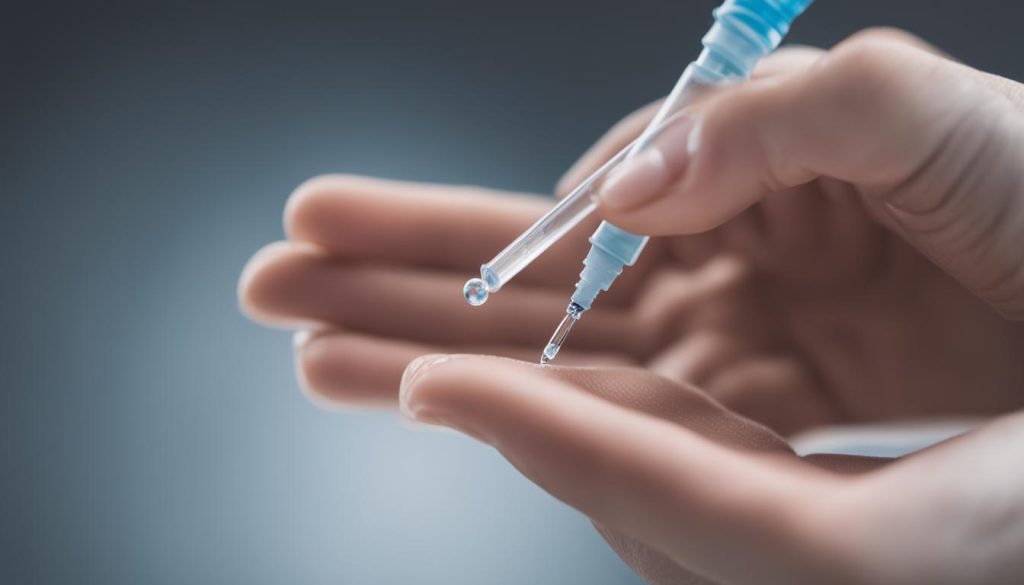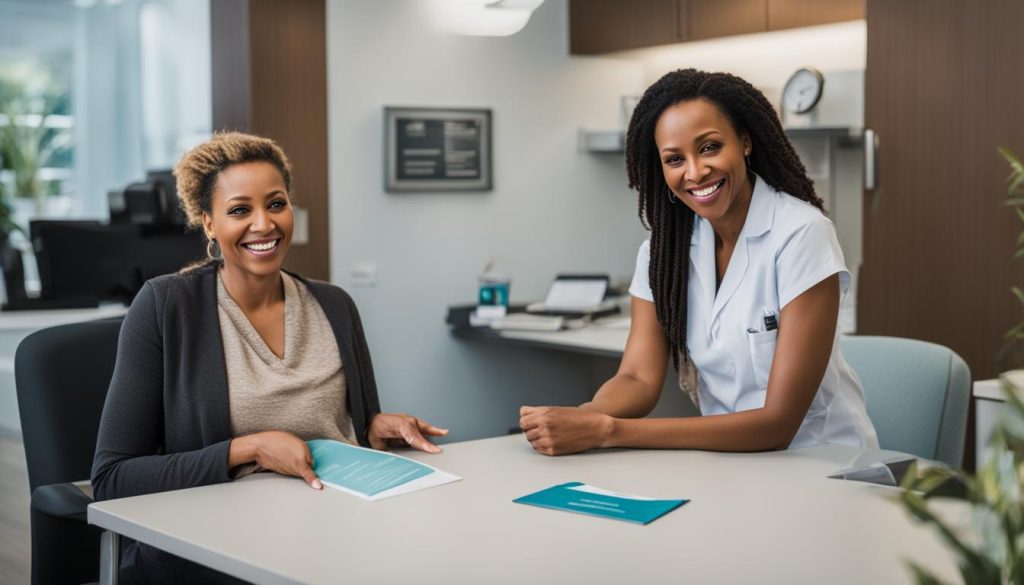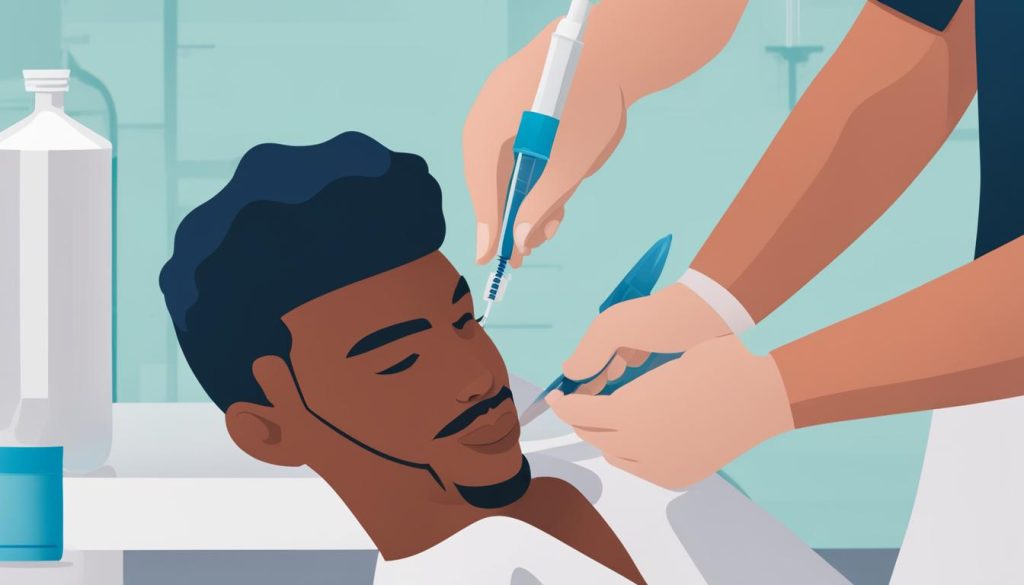Cervical cancer is a serious health concern that affects many women worldwide. Fortunately, there are steps you can take to prevent this disease and protect your health. In this article, I will outline simple and effective methods for preventing cervical cancer, including vaccination, regular screening tests, and healthy lifestyle choices.
How to Prevent Cervical Cancer
- Vaccination against HPV is a crucial step in preventing cervical cancer.
- Regular screening tests, such as Pap smears and HPV tests, can detect precancerous changes early.
- A healthy lifestyle, including not smoking and practicing safe sex, can further reduce the risk of cervical cancer.
- Following recommended screening guidelines and seeking appropriate medical care are essential for early detection and treatment.
- By taking these preventive measures, you can greatly reduce your chances of developing cervical cancer.
HPV Vaccination: Protecting Against Cervical Cancer
Human Papillomavirus (HPV) vaccination is an essential step in preventing cervical cancer. The HPV vaccine protects against the types of HPV that are most commonly associated with cervical, vaginal, and vulvar cancers. It is recommended for preteens aged 11 to 12 years but can be administered starting at age 9. The vaccine is also recommended for everyone up to the age of 26 years who has not been vaccinated already. Additionally, adults between the ages of 27 and 45 years who are not vaccinated may choose to discuss the potential benefits of vaccination with their doctor.
The HPV vaccine works by preventing new HPV infections, but it does not treat existing infections or diseases. By getting vaccinated, individuals can significantly reduce their risk of developing cervical cancer as well as other HPV-related cancers. It is important to note that the vaccine does not protect against all types of HPV, so it is still crucial to undergo regular cervical cancer screenings.
Types of HPV and Their Impact on Cervical Cancer
HPV refers to a group of over 100 related viruses, with some types having a higher risk of causing cervical cancer than others. The HPV types 16 and 18 are responsible for approximately 70% of all cervical cancer cases worldwide. Other high-risk HPV types include 31, 33, 45, 52, and 58. By receiving the HPV vaccine, individuals can protect themselves against the most prevalent high-risk types and further reduce their chances of developing cervical cancer.
The HPV vaccination is a safe and effective way to prevent cervical cancer, and its widespread adoption can have a significant impact on reducing the incidence of this disease. By combining HPV vaccination with regular screening tests, individuals can take proactive steps towards protecting their health and preventing cervical cancer.


Cervical Cancer Screening: Detecting Early Signs of Precancerous Changes
Regular cervical cancer screening tests are crucial for the early detection of precancerous changes in the cervix. The two most common screening tests are the Pap test (or Pap smear) and the HPV test. These tests can be performed in a doctor’s office or clinic and play a vital role in identifying potential abnormalities that may develop into cervical cancer if left untreated.
The Pap test specifically looks for precancerous cells on the cervix. It involves collecting a sample of cells from the cervix, which is then sent to a laboratory for analysis. By identifying these precancerous changes, healthcare providers can intervene promptly and provide the necessary treatment to prevent the progression to cervical cancer.
On the other hand, the HPV test detects the presence of the human papillomavirus (HPV), a common sexually transmitted infection that can lead to cervical cancer. HPV infection is a major risk factor for developing cervical cancer, and the HPV test helps determine if further diagnostic testing or follow-up is required.
Early Detection: A Crucial Step in Preventing Cervical Cancer
Cervical cancer screening is essential because it allows for the identification of precancerous changes at an early stage, when treatment is most effective. Detecting and treating these changes can prevent the development of cervical cancer and ultimately save lives. It is recommended that women begin regular cervical cancer screening at the age of 21 and continue at regular intervals as advised by their healthcare provider.
It’s important to note that screening guidelines may vary depending on individual factors such as age, medical history, and previous screening results. Therefore, it’s crucial to discuss the appropriate screening schedule with your healthcare provider.
Take Control of Your Health: Prioritize Cervical Cancer Screening
Cervical cancer screening empowers women to take control of their health and detect potential issues early on. By staying up-to-date with regular screenings, you can ensure that any precancerous changes or abnormalities are identified and addressed in a timely manner. Additionally, maintaining a healthy lifestyle and practicing safe sex can further reduce the risk of developing cervical cancer.
Remember, early detection is key in the fight against cervical cancer. By prioritizing cervical cancer screening and following the recommended guidelines, you can play an active role in protecting your health and well-being.
Additional Steps to Lower Your Risk of Cervical Cancer
In addition to getting vaccinated and undergoing regular screening tests, there are other steps you can take to lower your risk of cervical cancer. These include getting an HPV vaccine if you’re 26 or younger, not smoking, and using condoms during sex. While condoms can provide some protection against HPV, they are not foolproof. It’s important to practice safe sex and limit your number of sexual partners.
Getting the HPV vaccine is a proactive measure that can significantly reduce your risk of cervical cancer. The vaccine is recommended for preteens aged 11 to 12, but it can be given as early as age 9. If you’re between the ages of 13 and 26 and haven’t been vaccinated, it’s not too late to get protected. Talk to your healthcare provider to determine if getting the HPV vaccine is right for you.
Another important step in lowering your risk of cervical cancer is to quit smoking. Smoking has been linked to an increased risk of cervical cancer and can also make treatment less effective if cancer does develop. By quitting smoking, you can not only reduce your risk of cervical cancer but also improve your overall health.
Lastly, using condoms consistently and correctly can help reduce the risk of HPV transmission, which is the primary cause of cervical cancer. While condoms provide some level of protection, it’s worth noting that they do not cover all areas of potential HPV transmission. Therefore, it’s important to combine condom use with other preventive measures such as vaccination and regular screening tests.


The Importance of Cervical Cancer Prevention and Early Detection
Routine cervical cancer screenings, such as Pap smears, have played a significant role in preventing cervical cancer and detecting precancerous cells and early-stage malignancies that are more easily treatable. Studies estimate that Pap smear screenings have prevented thousands of cases of cervical cancer in the U.S. over the years. Early detection and treatment can greatly increase the chances of successful treatment and a positive outcome.
Regular screenings are essential for identifying any abnormalities in the cervix, including precancerous cells. A Pap smear is a simple and quick test that collects cells from the cervix to check for any changes that could indicate the presence of cervical cancer or precancerous conditions. Detecting these changes early on allows for timely intervention and treatment, reducing the risk of the disease progressing to advanced stages.
In addition to Pap smears, routine screenings may also involve HPV testing. This test checks for the presence of high-risk HPV strains that are known to cause cervical cancer. By identifying the presence of HPV, healthcare providers can assess the individual’s risk and recommend appropriate measures for prevention and management.
Cervical Cancer Screening Guidelines and Recommendations
Regular cervical cancer screenings are essential for early detection and prevention of cervical cancer. The American Cancer Society (ACS) provides guidelines and recommendations to help women stay proactive about their health.
ACS Guidelines
The ACS recommends that women aged 25 to 65 undergo cervical cancer screening every five years using an HPV test alone. If an HPV test alone is not available, a combination of an HPV test and a Pap test every five years or a Pap test alone every three years is suggested. Women who have had normal screenings in the past and are 65 years or older may not need further screenings.
Importance of Screening
Cervical cancer screening is crucial because it can detect any abnormalities or precancerous changes in the cervix. By identifying these changes early, medical professionals can intervene and provide appropriate treatment to prevent the progression to cervical cancer. Women should consult their healthcare provider to discuss the screening options and guidelines that are most suitable for their individual circumstances.


Regular screening tests, such as Pap tests and HPV testing, can help ensure early detection and increase the chances of successful treatment. By following the recommended guidelines and seeking appropriate medical care, women can take proactive steps to reduce their risk of developing advanced cervical cancer.
HPV Vaccination: Protecting Against Cervical Cancer
HPV vaccination is a crucial step in preventing cervical cancer. The HPV vaccine is designed to protect against the types of HPV that are most often responsible for causing cervical, vaginal, and vulvar cancers. It is recommended for preteens aged 11 to 12 years, but can be administered as early as age 9. Additionally, the vaccine is also recommended for individuals up to the age of 26 who have not been vaccinated yet. Some adults aged 27 to 45 may also opt for vaccination after discussing their risk factors and potential benefits with their healthcare provider. It is important to note that the HPV vaccine does not treat existing HPV infections or diseases, but rather helps prevent new infections.
The vaccine works by stimulating the immune system to develop antibodies against the specific types of HPV targeted by the vaccine. By doing so, it reduces the risk of developing HPV-related cancers. Vaccination not only protects the individual receiving the vaccine but also contributes to the broader goal of achieving herd immunity, which helps protect those who may not be able to receive the vaccine themselves, such as individuals with compromised immune systems.
Types of HPV Covered by the Vaccine
The HPV vaccine provides protection against the most common high-risk types of HPV that can cause cervical cancer, including HPV types 16 and 18. These two types are responsible for approximately 70% of cervical cancer cases worldwide. Additionally, the vaccine also protects against other types of HPV that can cause genital warts and certain types of cancers, such as anal, penile, vaginal, and vulvar cancers.


By getting vaccinated against HPV, individuals can significantly reduce their risk of developing cervical cancer and other HPV-related cancers. It is recommended to discuss HPV vaccination with a healthcare provider to understand the appropriate timing and potential benefits based on personal circumstances.
Lifestyle Factors That Can Reduce Cervical Cancer Risk
Cervical cancer prevention goes beyond vaccination and regular screening tests. Adopting a healthy lifestyle and avoiding risky behaviors can significantly reduce the risk of developing cervical cancer. By making some simple changes, you can take proactive steps towards protecting your health.
Firstly, quitting smoking is crucial for cervical cancer prevention. Tobacco smoke contains harmful chemicals that can damage the DNA in cervical cells, increasing the risk of cancer. By quitting smoking or avoiding exposure to secondhand smoke, you can lower your chances of developing cervical cancer.
Additionally, maintaining a healthy diet rich in fruits, vegetables, and whole grains can help reduce cancer risk. These foods provide essential nutrients and antioxidants that support a strong immune system and help prevent cell damage. Regular exercise is also important, as it can help maintain a healthy weight and boost overall well-being.
Furthermore, it is important to practice safe sexual behaviors to reduce the risk of HPV infection, a key factor in cervical cancer development. Limiting the number of sexual partners and using condoms consistently and correctly can help reduce the transmission and spread of HPV. By prioritizing your health and making these lifestyle choices, you can play an active role in preventing cervical cancer.
Reducing Cancer Risk: Key Points
- Quit smoking or avoid exposure to secondhand smoke
- Follow a healthy diet rich in fruits, vegetables, and whole grains
- Incorporate regular exercise into your routine
- Practice safe sexual behaviors, including limiting sexual partners and using condoms consistently
Cervical Cancer Prevention: The Role of Vaccination and Lifestyle Choices
Preventing cervical cancer requires a proactive approach that combines vaccination against Human Papillomavirus (HPV) and the adoption of a healthy lifestyle. HPV vaccination provides crucial protection against the specific types of HPV that can cause cervical cancer. It is recommended for preteens and young adults, offering a powerful defense against infection and subsequent cancer development. By getting vaccinated, individuals can significantly reduce their risk of developing cervical cancer.
In addition to vaccination, making informed lifestyle choices plays a vital role in reducing the risk of cervical cancer. Incorporating healthy habits such as not smoking, maintaining a balanced diet, and engaging in regular exercise can further lower the chances of developing this type of cancer. Consistent practice of safe sexual behaviors, including the use of condoms and limiting the number of sexual partners, also helps minimize the risk of HPV infection, which is a leading cause of cervical cancer.
By combining the protective effects of HPV vaccination and the maintenance of a healthy lifestyle, individuals can take proactive steps toward preventing cervical cancer. These efforts are essential in safeguarding women’s health and well-being. By prioritizing prevention strategies and adhering to recommended guidelines, individuals can significantly reduce their risk and contribute to the overall decline of cervical cancer cases.
The Impact of Cervical Cancer Prevention and Early Detection Efforts
Preventing cervical cancer relies on a combination of effective prevention and early detection efforts. By following recommended screening guidelines and adopting healthy lifestyle choices, women can significantly reduce their risk of developing advanced cervical cancer.
Regular screenings, such as Pap smears and HPV tests, play a crucial role in detecting precancerous changes and early-stage cancers. These screenings allow for timely intervention and improved treatment outcomes. Routine screenings have been instrumental in reducing cervical cancer cases and deaths.
In addition to screenings, vaccination against the human papillomavirus (HPV) is a key preventive measure. HPV vaccination protects against the most common types of HPV that can lead to cervical cancer. By preventing new HPV infections, vaccination offers further protection against this devastating disease.
The Importance of Early Detection
Early detection of cervical cancer is crucial for successful treatment. Routine screenings allow for the identification of precancerous cells or early-stage malignancies, which are more easily treatable. Detecting and treating cervical cancer in its early stages greatly improves the chances of a positive outcome.
It is vital for women to prioritize their health and undergo routine screenings as recommended by healthcare professionals. These screenings, along with vaccination and healthy lifestyle choices, form a comprehensive approach to cervical cancer prevention and early detection.
The Importance of Cervical Cancer Prevention and Screening for Women’s Health
Cervical cancer prevention and screening are crucial aspects of maintaining women’s health. By prioritizing preventive measures such as the HPV vaccine and routine screenings, women can protect themselves against cervical cancer and ensure early detection of any abnormalities. Regular screenings, including Pap smears and HPV tests, play a vital role in identifying precancerous changes or early-stage cancers, enabling prompt treatment and better outcomes.
One essential component of cervical cancer prevention is the HPV vaccine. Administered to preteens and young adults, the vaccine provides protection against the types of HPV that can cause cervical cancer. By getting vaccinated, women can significantly reduce their risk of developing this potentially life-threatening disease.
In addition to vaccination, routine screenings are essential for early detection. Pap smears and HPV tests can identify any cellular changes or signs of the human papillomavirus that may lead to cervical cancer. Regular screenings allow for timely intervention and treatment, increasing the chances of successful outcomes.
Women’s health should always be a priority. By following recommended guidelines for cervical cancer prevention and engaging in routine screenings, women can take proactive steps to protect themselves against this disease. Together with the HPV vaccine, regular screenings contribute to overall well-being and peace of mind, allowing women to actively safeguard their health.
Conclusion
In conclusion, preventing cervical cancer requires a multi-faceted approach that encompasses HPV vaccination, regular screening tests, and adopting a healthy lifestyle. The HPV vaccine is an essential tool in protecting against the types of HPV that can lead to cervical cancer. By getting vaccinated, individuals can significantly reduce their risk of developing this disease.
In addition to vaccination, regular screening tests such as Pap smears and HPV tests are crucial for early detection of any precancerous changes or early-stage cancers. These tests play a vital role in identifying potential abnormalities and allowing for prompt treatment, ultimately improving outcomes.
Furthermore, maintaining a healthy lifestyle is essential in preventing cervical cancer. By adopting habits such as not smoking, eating a balanced diet, and engaging in regular exercise, individuals can further reduce their risk. Safe sexual practices, such as limiting the number of sexual partners and practicing protected sex, also play a significant role in prevention.
By prioritizing HPV vaccination, regular screening tests, and a healthy lifestyle, individuals can greatly reduce their chances of developing cervical cancer. Taking these proactive steps is crucial in protecting one’s health and ensuring early detection if any abnormalities arise. Together, we can work towards a future where cervical cancer is preventable and lives are saved.
FAQ
What are the most important things I can do to prevent cervical cancer?
The most important steps to prevent cervical cancer are getting vaccinated against HPV, having regular screening tests, and seeking further medical attention if your screening test results are abnormal.
Who is recommended to receive HPV vaccination?
HPV vaccination is recommended for preteens aged 11 to 12 years, but can be given starting at age 9. It is also recommended for everyone through age 26 years, if they are not already vaccinated.
Can adults over age 26 receive the HPV vaccine?
Some adults age 27 through 45 years who are not already vaccinated may decide to get the HPV vaccine after speaking with their doctor about their risk for new HPV infections and the possible benefits of vaccination.
What is the purpose of a Pap test?
The Pap test, or Pap smear, looks for precancers and cell changes on the cervix that could become cervical cancer if left untreated.
What does the HPV test detect?
The HPV test looks for the presence of the human papillomavirus (HPV), which can cause cell changes on the cervix that may lead to cervical cancer.
How often should I have screening tests for cervical cancer?
Regular screening tests are important to detect any changes that could become precancer or cervical cancer. The frequency of screening depends on age and the type of test, so it’s best to discuss screening options and guidelines with your healthcare provider.
What are some additional steps I can take to lower my risk of cervical cancer?
In addition to vaccination and screening tests, you can lower your risk of cervical cancer by getting an HPV vaccine if you’re 26 or younger, not smoking, and using condoms during sex.
Can condoms fully protect against HPV infection?
While condoms can provide some protection against HPV, they are not foolproof. It’s important to practice safe sex and limit your number of sexual partners to further reduce the risk of HPV infection.
How effective are screening tests in preventing cervical cancer?
Routine cervical cancer screenings, such as Pap smears, have played a significant role in preventing cervical cancer and detecting precancerous cells and early-stage malignancies that are more easily treatable.
What are the latest guidelines for cervical cancer screening?
The American Cancer Society recommends a preference for HPV testing alone every five years for women ages 25 to 65. If HPV testing alone is not available, a combined HPV/Pap test every five years or a Pap test every three years is recommended. Women 65 and older who have had normal prior tests may not need further screenings.
What is the role of HPV vaccination in preventing cervical cancer?
HPV vaccination is a key step in preventing cervical cancer. It protects against the types of HPV that most often cause cervical, vaginal, and vulvar cancers.
What lifestyle factors can reduce the risk of cervical cancer?
Maintaining a healthy lifestyle by not smoking, eating a balanced diet, engaging in regular exercise, limiting sexual partners, and practicing safe sex can help lower the risk of developing cervical cancer.
How have cervical cancer prevention and early detection efforts impacted the disease?
Cervical cancer prevention and screening efforts have significantly reduced the number of cervical cancer cases and deaths. Early detection allows for more successful treatment and improved outcomes.
Why is cervical cancer prevention and screening important for women’s health?
Prioritizing cervical cancer prevention through vaccination and routine screenings helps protect women’s health by preventing the development of advanced cervical cancer and promoting early detection of abnormalities.
How can I prevent cervical cancer?
By following simple steps such as HPV vaccination, regular screening tests, and adopting a healthy lifestyle, you can greatly reduce your chances of developing cervical cancer.
